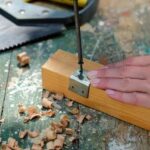What is the strongest woodworking joint? For anyone involved in woodworking, this question is crucial to creating sturdy and durable woodwork projects. The strength of a woodworking joint can determine the longevity and stability of furniture, cabinets, and other wooden structures. In this article, we will explore the various types of woodworking joints and delve into which ones are considered the strongest.
Woodworking joints are essential for connecting two pieces of wood together to create a solid and cohesive structure. Without strong joints, woodwork projects are prone to structural weaknesses and may not withstand the test of time. Understanding the importance of strong woodworking joints is vital for anyone looking to create high-quality and long-lasting wooden pieces.
In this section, we will provide an overview of the different types of woodworking joints and discuss the significance of choosing the right joint for strength. We will delve into factors to consider when selecting a woodworking joint for maximum sturdiness and durability. By understanding the fundamentals of woodworking joints, readers will gain insight into what makes a joint strong and how it contributes to the overall integrity of a woodwork project.
Understanding Woodworking Joints
Woodworking joints are crucial in creating strong and durable wood structures, making them an essential aspect of any woodworking project. There are various types of woodworking joints, each with its own unique characteristics and strengths. Understanding the different types of woodworking joints is important for choosing the right one for a specific project. Let’s take a closer look at some common woodworking joints and their features.
One of the most popular and strongest woodworking joints is the mortise and tenon joint. This traditional joint consists of a protruding tenon piece that fits into a hole or slot (mortise) in the adjoining piece. The interlocking design provides excellent strength, making it suitable for constructing furniture, doors, and frames. The simplicity of this joint also makes it a favorite among woodworkers.
Another strong contender is the dovetail joint, known for its resistance to pulling forces. This joint features fan-shaped interlocking tails on one piece that fit into matching pins on the adjoining piece. The precision required to create dovetail joints adds to their strength and durability, making them ideal for drawer construction and cabinetmaking.
For those looking for an alternative strong joint option, the finger joint can be considered. Also known as a box joint, this type of joint connects two pieces by interlocking alternating rectangular fingers. Despite requiring more material than other joints, the large surface area contact between the fingers results in impressive strength and resistance to pulling forces.
In summary, understanding different types of woodworking joints is essential for selecting the strongest option for any project. While there are many factors to consider when choosing a woodworking joint for strength, including wood type and load-bearing requirements, mortise and tenon, dovetail, and finger joints are among the top choices due to their exceptional durability and ability to withstand forces.
| Woodworking Joint Type | Strengths |
|---|---|
| Mortise and Tenon Joint | Excellent strength due to interlocking design |
| Dovetail Joint | Resistance to pulling forces; ideal for drawers and cabinets |
| Finger Joint (Box Joint) | Large surface area contact; impressive strength against pulling forces |
Factors to Consider When Choosing a Woodworking Joint for Strength
When it comes to woodworking, choosing the right joint is crucial for creating strong and durable pieces. There are several factors to consider when determining which woodworking joint will provide the most strength for your project.
One important factor to consider is the type of stress that will be placed on the joint. Will the joint need to support weight or movement? Understanding the specific demands of your project will help you determine which joint will provide the necessary strength.
Another consideration is the type of wood being used. Some woods are more prone to splitting or warping, so it’s important to choose a joint that can accommodate the characteristics of the wood being used. Additionally, the size and shape of the wood pieces being joined should also be taken into account when selecting a woodworking joint for strength.
Lastly, consider the skill level and tools available. Some joints require more advanced techniques and specialized tools, so it’s important to choose a joint that aligns with your expertise and equipment. Taking these factors into consideration will help you determine what is the strongest woodworking joint for your specific project needs.
| Woodworking Joint | Strength Rating (1-5) |
|---|---|
| Mortise and Tenon | 5 |
| Dovetail | 4 |
| Finger Joint | 3 |
Mortise and Tenon Joint
The mortise and tenon joint is widely considered to be one of the strongest woodworking joints available. This traditional joint has been used for centuries and is still preferred by many woodworkers today due to its strength and durability.
The joint consists of a mortise, which is a hole or slot cut into the wood, and a tenon, which is a projection on the end of a piece of wood that fits into the mortise. When properly constructed, this joint provides a large glue surface area, making it incredibly sturdy and able to withstand significant amounts of force.
One of the reasons why the mortise and tenon joint is so strong is because it has a large glue surface area, ensuring that there is ample bonding between the two pieces of wood. Additionally, the design of this joint allows for a tight fit between the mortise and tenon, resulting in minimal movement and increased structural integrity. This makes it an ideal choice for furniture making, timber framing, and other applications where strength is essential.
When considering what is the strongest woodworking joint, it’s important to factor in both the type of wood being used and the specific application. Different woods have varying levels of hardness, density, and grain patterns that can affect how well they hold different types of joints.
Additionally, certain woodworking projects may require joints that can withstand heavy loads or constant movement. In these cases, the mortise and tenon joint may be the best option due to its proven track record for strength and reliability.
Dovetail Joint
The dovetail joint is a popular and highly regarded woodworking joint known for its strength and durability. This type of joint is commonly used in cabinetmaking, furniture construction, and other woodworking projects where a sturdy and long-lasting connection is essential. The dovetail joint derives its name from the shape of the interlocking components, which resemble the tail of a dove.
There are two main types of dovetail joints: through dovetails and half-blind dovetails. Through dovetails are visible from both sides of the material and are often used in exposed areas where aesthetics are important, such as on the front of drawers. Half-blind dovetails, on the other hand, are concealed within the material and are commonly used for drawer construction.
One of the key factors that contribute to the strength of dovetail joints is their interlocking design, which provides ample mechanical support against pulling forces. The angled slope of the tails and pins also helps distribute weight evenly across the joint, reducing stress on individual components. As a result, dovetail joints are less likely to pull apart or loosen over time compared to other types of woodworking joints.
When considering the strongest woodworking joint, it’s important to acknowledge that while the mortise and tenon joint may be considered by many as the strongest option available; however, dovetail joints come close due to their intricate design and interlocking components that provide exceptional strength and durability. With proper craftsmanship and attention to detail, a well-executed dovetail joint can provide an incredibly strong connection between wooden pieces for countless years to come.
Finger Joint
In the world of woodworking, the strength of a joint is crucial for the durability and longevity of the finished piece. While traditional joints like mortise and tenon and dovetail are widely regarded as some of the strongest options, there are alternative joints that offer impressive strength as well. One such option is the finger joint, also known as a box joint, which has been used for centuries in woodworking for its robust construction.
Understanding the Finger Joint
The finger joint is created by interlocking alternating rectangular cuts, resembling interlocking fingers when joined together. This unique design provides a large gluing surface area, resulting in a joint with exceptional strength and resistance to forces applied from different directions. As a result, it is commonly used in creating strong connections between pieces of wood where rigidity and endurance are vital.
Applications of Finger Joints
Finger joints are often utilized in furniture construction, especially in drawer boxes and cabinetry where strong connections are essential to withstand constant opening and closing. Additionally, they are favored in structural applications such as creating panels and frames, offering stability and robustness to the overall structure. The ability of finger joints to distribute stress evenly makes them an ideal option for projects that require reliable joinery.
When considering what is the strongest woodworking joint, it’s important to recognize the finger joint as a worthy contender due to its remarkable strength and suitability for various woodworking applications. Whether used traditionally or incorporated into modern techniques for reinforcing joints, the finger joint remains a valuable choice for creating durable and long-lasting woodwork pieces.
Modern Techniques for Reinforcing Woodworking Joints for Added Strength
In addition to using traditional woodworking joint techniques, modern woodworkers have also developed innovative ways to reinforce joints for added strength. These modern techniques can provide extra support and durability to woodworking projects, ensuring they withstand the test of time.
Glue and Dowel Reinforcement
One common modern technique for reinforcing woodworking joints is the use of glue and dowels. When joining two pieces of wood together, adding dowels alongside a strong adhesive can enhance the joint’s strength significantly. This method is commonly used for butt joints and miter joints, providing additional support and stability.
Reinforcing With Metal Plates or Brackets
Another modern approach to reinforcing woodworking joints is by incorporating metal plates or brackets into the joint structure. These metal reinforcements are often used in conjunction with traditional jointing methods such as mortise and tenon or dovetail joints, providing added strength and stability to the overall structure. Metal plates or brackets can be particularly useful in load-bearing applications where extra reinforcement is necessary.
Use of Epoxy Resin
Epoxy resin has become a popular choice for reinforcing woodworking joints due to its exceptional bonding strength. This modern technique involves applying epoxy resin to the joint before assembly, creating a powerful bond that adds significant durability to the joint. Epoxy resin can be particularly effective in strengthening end grain joints, which are inherently weaker than other types of joints.
These modern techniques for reinforcing woodworking joints offer woodworkers an array of options to ensure their projects are not only aesthetically pleasing but also structurally sound and long-lasting. By carefully selecting and implementing these reinforcement methods, woodworkers can create strong and durable joints that will stand the test of time.
Examples of Projects Where Strong Woodworking Joints Are Essential
Strong woodworking joints are essential for a variety of projects, especially those that require structural integrity and durability. Whether you are building furniture, cabinetry, or even structural supports, choosing the right woodworking joint is crucial to the overall strength and longevity of the project. Here are some examples of projects where strong woodworking joints are essential:
- Dining table construction: When building a dining table, it’s important to consider the weight it will bear and the wear and tear it will endure over time. Using strong woodworking joints like mortise and tenon or dovetail joints can ensure that the table remains sturdy and stable, even with daily use.
- Cabinet making: Cabinets are often subjected to heavy loads from dishes, pots, and pans. Therefore, strong woodworking joints are crucial for ensuring that cabinets can hold up over time without sagging or becoming unstable.
- Outdoor structures: Building outdoor structures such as pergolas, arbors, or garden benches requires joints that can withstand exposure to the elements. Utilizing strong woodworking joints that can resist warping and movement due to temperature changes is essential for outdoor projects.
These examples highlight just a few instances where choosing the strongest woodworking joint is paramount for the success of a project in terms of strength, stability, and longevity.
In summary, understanding the specific demands of a project and selecting the appropriate woodworking joint is crucial for achieving the desired level of strength. Whether it’s a large dining table, a set of kitchen cabinets, or an outdoor structure, considering which type of joint will provide optimal strength is vital when planning any woodworking project.
Ultimately, by carefully choosing the strongest woodworking joint for each specific application, woodworkers can ensure that their projects not only meet their aesthetic expectations but also stand the test of time in terms of durability and strength.
Conclusion
In conclusion, when it comes to the question of what is the strongest woodworking joint, the mortise and tenon joint stands out as the tried and true option. This classic joint has been used for centuries and continues to be a go-to choice for woodworkers looking for maximum strength and durability in their projects. The precision fit and long-grain to long-grain contact make this joint exceptionally strong, making it suitable for a wide range of woodworking applications.
While the mortise and tenon joint may be considered the strongest woodworking joint, it is important to also consider other options such as the dovetail joint and finger joint. Both of these joints offer impressive strength and durability, with the dovetail joint being a close contender to the mortise and tenon in terms of overall strength.
Each of these joints has its own unique characteristics and applications, providing woodworkers with diverse options for creating strong and reliable connections in their projects.
Ultimately, the choice of woodworking joint will depend on various factors including project requirements, aesthetics, skill level, and available tools. It is important for woodworkers to carefully consider these factors when choosing a woodworking joint to ensure that they achieve both the desired strength and visual appeal in their finished pieces. Additionally, modern techniques for reinforcing woodworking joints can provide added strength and stability, allowing woodworkers to push the limits of traditional joinery methods in pursuit of even stronger connections.
Frequently Asked Questions
What Is the Strongest Way to Join Two Pieces of Wood?
The strongest way to join two pieces of wood is through a method called a “dovetail joint.” This type of joint involves interlocking wedge-shaped projections that provide a strong and durable connection between the two pieces of wood.
What Are the Most Difficult Woodworking Joints?
Some of the most difficult woodworking joints include the complex “mortise and tenon joint,” which involves intricate cutting and fitting of wood, as well as the “dovetail joint” due to its precision and skill needed for proper assembly.
What Is the Weakest Joint in Woodworking?
The weakest joint in woodworking is often considered to be the simple “butt joint.” This type of joint involves simply butting two pieces of wood together without any additional support or reinforcement, resulting in a weaker and less stable connection compared to other types of joints.

Hi everyone! I’m a woodworker and blogger, and this is my woodworking blog. In my blog, I share tips and tricks for woodworkers of all skill levels, as well as project ideas that you can try yourself.





